关于《模拟城市建造》中的进程控制
作者:Philipp Zupke
我进一步研究了成功的免费手机游戏《模拟城市建造》。为了理解设计师的意图,我在游戏过程中记下了许多数据点。
首先我将简单介绍下本文的关注点:玩家进程。
进程
游戏是关于玩家追逐一个目标。为了实现该目标,玩家需要完成一系列子目标。“进程”是关于玩家前进了多远,距离目标还有多长距离。这通常指代在前进的过程中消耗游戏内容。内容将因为玩家沉浸于游戏机制中而不断被消耗掉。例如为了在一款RPG中前进(进程==级别,道具,故事),玩家需要不断与敌人(障碍)进行战争(核心机制)。那么在《模拟城市建造》中的进程是什么呢?在模拟游戏或社交游戏中,通常都不存在最终目标。玩家只会不断成长并不断探索。通常情况下总是会出现经济挑战去阻碍玩家实现目标。从长期发展与盈利性来看,有效控制游戏进程是这类型游戏成功的关键。
进程控制目标
学习曲线与推动新玩家
为了避免玩家在游戏一开始承受太多游戏机制或系统,游戏就需要逐渐呈现一些新功能。在适当的时候呈现给玩家一定内容能够让他们在接触之后的内容前先了解当下的内容。为了延伸内容而逐渐打开一些功能(主要是出于盈利目标)与提供顺畅的学习曲线间具有微妙的差别。这将引出:
生命周期
为了克服设计师添加到游戏中的进程阻滞剂,玩家通常需要反复执行同样的循环。这将增加他们花费于同样内容中的时间。这种情况只适用于核心游戏玩法具有较高重玩价值的时候。
吸引玩家
打开并呈现许多内容,并确保这些内容足够有趣。确保玩家在游戏早期阶段始终对游戏充满兴趣并逐渐呈现给他们完整的功能集。一旦玩家开始沉浸于其中便可以开始减缓内容的呈现速度。
长期目标
拥有明确且可衡量的目标,如一个级别将提供给玩家一些具有期待性的内容。特别是当他们知道什么样的游戏元素能够帮助自己到达下一个关卡(游戏邦注:如打开新建筑,功能或其它内容)。
如何发挥作用
打开新内容或机制的速度可以慢一点,因为玩家可能不断投入更多时间于早前打开的能力中。玩家与之互动的数字系统或者现有内容的复杂性通常会随着时间的发展而提升。这意味着随着玩家的前进,他们便能够投入更多时间于不同的游戏部分。例如乐高,一开始你需要许多组件进行创建。而太多组件可能会带给孩子太多负担。尽管获得更多组件(长期目标)是有价值的(奖励),但是孩子们愿意花时间去等待在圣诞节时收集到所有的组件。
如何控制进程
我们可以找到一些游戏元素影响着玩家进程的例子。级别阀值。在使用级别系统的游戏中,通过调整XP曲线而控制进程速度是很常见的做法。XP需要伴随着每个级别不断提高。通常情况下XP数值也要不断增加(如此玩家便可能看到自己的前进)。但却要基于比阀值更低的速度。
图1:XP需求的增长速度快于XP数值
添加系统或复杂性
在MMO中,有时候引进非XP奖励系统(如锻造或PVP机制)将会减慢玩家进程。就像在《文明》中有些回合会变得更长,因为这里的复杂性变得更高了(关于城市,单位,外交选择的数量)。
难度/随机性能够通过让玩家遭遇失败并不断重复而控制玩家消费内容的速度。就像在益智游戏中,游戏会为了要求玩家完成更多回合游戏而设定一些更复杂(或更随机)的级别。
《模拟城市建造》
我将主要谈论锻造系统与玩家进程之间的关系。
游戏
《模拟城市建造》的游戏概念便是最初的《模拟城市》系列归结下来的2个系统:《卡通农场》般的锻造与最初《模拟城市》或《Anno》系列中的城市建造机制。我们仍然可以辨认出《模拟城市》中广为人知的RCI Zones(住宅,商业和产业区)概念,但它们仅是基于主题而存在着。
核心游戏玩法
锻造是整体经济的领跑者。所有的一切都依赖于玩家创造自己能够用于升级住宅建筑或通过交易而转变成软货币的产品的能力。玩家将通过创建住宅建筑(在升级的时候也能够增加城市的居民数量)而扩展自己的城市。住宅建筑需要包含公共设施和服务性建筑,如发电厂,医院等等。添加一栋住宅建筑到城市中将以提供足够的服务和公共设施为代价。这些支持醒建筑的建造需要使用软货币。为了最大化支持性建筑的作用,玩家需要时不时重新对自己的城市进行布局。满足市民的需求能够提升他们的幸福感,并换来更多税收。
《模拟城市建造》的进程
玩家的目标是扩展自己的城市。许多控制进程的系统都是与玩家级别维系在一起。尽管从系统角度看来它们可能只是作为一种负担,但是对于玩家来说它们却是玩家为了实现目标而想要努力克服的挑战。当平衡免费游戏的进程时,挑战与驱逐玩家间的最有效点是在艰难的任务之间。
软货币
对于进程来说,软货币经济与升级房子一样重要。通过添加住宅建筑,玩家将扩展城市并增加人口的需求,软货币也能够用于满足市民的这些需求。玩家拥有两种选择去增加人口(图2):
创建更多房子(这将增加公共设施或服务成本)
通过创建公园或“关键”建筑而推动人口的增加
图2.每个住宅都拥有游戏所提供的潜在人口数量
后者并不能添加公共设施费用。因为并未出现新建筑,所以服务成本(即能够带给市民幸福感的建筑)仍然保持不变。但是因为设计师通过在现有的房子中添加了显著的成本去增加人口数,所以他们需要对这一策略负责:玩家需要为了确保待在这些房子中的市民能够感到高兴而消费大量软货币去升级道路。软货币的生成主要是基于3种方式。
1.销售产品(交易或随机交易)
2.升级建筑
3.税收
软货币有3种输出方式:
每建造一个房子便会增加1个单位的公共设施成本(水,电,污水)。
服务(通过覆盖周边区域而满足一定需求的建筑)
公园和学校能够推动人们住在房子里
交易
奖励升级的随机软货币
每次升级的货币奖励都是不同的。它们总是伴随着一定的范围。玩家所获得的软货币数会随着级别而不断增加,范围也是如此。通过随机化奖励,游戏变得更加难以预测,整体的进程感也比固定奖励更加自然。
图3:奖励升级建筑的软货币是处于随机范围内
税收
幸福感和人口规模经常用于决定市政厅的软货币制作。幸福感能够决定税级,并且是基于特定的人口比例。
收入并非直线上升。就像你在图4中所看到的那样,每个市民的税收收入将伴随着人口的增加而下降,这意味着人口的增加会导致收益的递减。换句话说:随着城市的壮大,增加人口规模变得越不划算。但是添加每个人口的成本仍是一样的。因为税收系统对于沉浸于游戏中的玩家的进程并不具有太大影响,这只是一个小小的进程抑制机制。
图4:在不同人口规模下每个市民的税收收入
需求和公共设施
图5:每个住宅建筑都带有对幸福感级别具有影响的需求。这些需求将会因为建造各种设施而得到满足。
在早前游戏阶段,游戏并不需要提供任何服务给市民。玩家将逐渐去打开它们。如果并未提供服务,市民的幸福感便不会下降(图5)。这引出了一个新的货币输出方式,未能带给玩家任何额外好处。玩家需要为了维持当前的游戏状态而投资软货币。所以每当玩家打开一个新的需求,或建造一个全新的住宅,这都会创造出需要消耗软货币的成本。在图6中你将能够看到贯穿游戏每次额外的建造所花费的成本。
我们可以通过叠加满足需求的平均成本去计算每个住宅建筑的成本。当玩家在游戏中走得越远,他们便需要花费更多软货币从住宅建筑中获得幸福感。因为幸福感是源自使用软货币购买建筑而获得,如此花在获取软货币去支持住宅建筑的时间也会跟着增加。
每次当玩家打开一个新的需求或安置一栋全新的住宅建筑时,幸福感便会下降。
在赚取足够的软货币之前,玩家将经历不断的扩展与刷任务的循环过程。
我们需要在减缓的进程中投入更多时间。还存在另外一个进程会抑制这种副作用。玩家需要在打开新的需求时改变并优化自己的城市。当安置新建筑的时候他们也可以让其它建筑提供给住宅建筑幸福感。因为住宅建筑将变得更宽阔并为新的公共设施和特殊建筑提供空间,而需要带有服务性的区域将变得比新添加的住宅建筑更大。
玩家的目标也会随着他们的移动而发展。但却永远都不可能出现一种稳定的状态。
货币输出系统便是Red Queen Dilemma(玩家需要更努力去维持当前的游戏状态)的典型例子。基于这种方法,在玩家打开全新人口需求时的每次升级都将成为一个潜在的盈利点。这种类型的系统便是免费游戏经济的平衡。在《模拟城市建造》的这一系统中我所看到的一个问题是升级并不是很有效,因为游戏与软货币经济紧密维系在一起,所以避免升级才是一种有效的策略。升级并不是一种奖励,因此并不能被当成是玩家的目标。
XP和级别
升级住宅区
升级建筑是《模拟城市建造》中的一个核心能力与目标。这是玩家赚取XP的唯一方式也是获得软货币的众多方式之一。住宅建筑可以升级5次,每一次都将提供XP和货币并增加人口。这意味着通过添加一栋新建筑,玩家便能够创造货币和XP的来源。因此玩家能够获得的XP总数是受限于已经建好的住宅建筑。
图7:玩家需要多少XP才能获得升级?
在图7中你可以看到XP曲线,即表示特定级别所需要的XP数。这样的曲线在一开始并未出现明显变化。关于这类型曲线的有趣问题是,它是基于怎样的速度提高的?通常情况下速度的提高也会创造指数的增长。所以为了获得这一数值,我们需要着眼于不同级别间所需XP的增长。
图8:通过着眼于XP曲线的增量,我们了解了每个级别的XP阀值。
现在事情开始变得更有趣了!就像你所看到的XP需求并不是稳定增长。对于住宅建筑的每次升级,玩家都将获得XP。XP奖励数是随机的,这似乎是受到级别的影响。基本速度将随着级别的增加而提高。因为XP收入通常都是呈上升趋势。为了向玩家传达进程感,这些数值需要一直增加着。因为升级等于XP,所以我们可以通过着眼于特定级别所提供的XP而计算级别所需要的升级数,并使用它去划分该级别所需要的XP数(图9)。
图9.为了到达下一个级别需要执行多少住宅升级。
图10呈现出的是每个级别所需要的升级次数的区别。这意味着玩家将出现不同的升级速度。
图10.“不同级别所需要的升级”的不同。有些级别快于其它级别。
通过设定一些波动,进程显得不那么僵硬且不好预测。伴随着一些碰撞的进程比绝对线形的进程更有趣。如此便能够创造出一些较慢与较快的级别。有时候所需升级数呈下降趋势也是有趣的。设计师可以通过维持整体的缓慢增长态势而创造出明显的“碰撞”。
锻造
锻造是游戏玩法的核心,所有的一切都是围绕着它进行的。整体设计与大多数进程都是由该系统所控制。通过锻造玩家能够创造XP和软货币—-即他们在前进过程中所需要的两种资源。基于不断的压力,玩家将始终确保锻造队列的运行。当玩家获得升级时,锻造系统将给予多个暗示。因为不断提高的复杂性,它们最终都将减缓进程的速度。
提高每次升级的材料需求
住宅升级的材料需求取决于3大要素(图11):
材料槽的数量
材料类型
材料数量
图11:升级需要特定数量的不同产品类型
产品需求槽
为了升级第一回合的住宅建筑,玩家只需要管理有限的产品便可。这将导致第一回合拥有较高的升级率。关于玩家库存中拥有什么以及房子升级需要什么之间总是存在争斗。因为计时器很快且要求较低,所以这里的核心循环通常都能更频繁且更快速地执行着。
图12.特定级别中的需求槽数量。更多槽意味着玩家需要执行更多任务。
这通常是免费模拟游戏的早前阶段所呈现出的情况。这也是受到锻造系统的控制。额外的产品需求槽将在之后的游戏过程中出现。自然地增加所需产品将导致玩家花费更多时间于核心循环中。换句话说,每次升级都需要玩家更加投入于游戏中。这一机制具有一定的副作用:每个槽将随机生成不同的材料类型和数量。所以如果是为了升级而增加槽的数量的话,库存管理压力也会随之增加。
打开产品类型
随着玩家的前进,他将打开全新产品并扩大需求的范围。获得全新产品同样也意味着为这类型产品创建相关建筑(游戏邦注:如果它是新产品的话)。创造这种生产设施当然需要消耗货币。一旦玩家打开一个全新的产品类型,它便会呈现出对于住宅建筑的升级需求。获得更多锻造产品将推动玩家进一步考虑库存管理。随着玩家打开每个全新的产品,玩家便更有可能达到库存限制。这也将推动他们为了获得增加库存或摆脱多余产品的所需材料而使用交易系统。尽管全新材料类型将让玩家处于一个不利位置,但这却能够保持游戏的乐趣。如果一直创造出同样的道具的话玩家很快便会感到无聊。基于多种可能的产品,玩家将计划并组织他们的产品顺序,这也将成为游戏中的挑战之一。从可扩展性来看这同时也会对这一系统产生限制性。基于更长的计时器或更复杂的方法添加太多锻造产品并不会让游戏变得更加有趣。
方法的复杂性
随着游戏的前进,不仅是产品的计时器会变得更长,同时方法也会变得更复杂。在游戏早期,需要升级建筑的产品往往只是一些初级产品。
在游戏中间阶段,被打开的更多产品将需要一些原材料。
这将增加产品的制作时间,因为时间将被添加到真正的制作过程中。这一升级需要2件初级产品,但同时3种类型的“第2层”产品也需要初级产品。
然后甚至还有一些产品需要源自原材料而锻造出的成分。
为了升级这样的建筑,玩家便需要锻造出许多产品。
3维缩放
拥有3条轴线去平衡核心循环能够让设计师基于不同方式去调整系统,同时也能够优化“时间级别”。
XP与锻造系统
现在我将结合这些机制去呈现出随着时间的发展而发展的进程。再一次地,进程意味着“朝游戏的最终目标移动”,在《模拟城市》中,这指的是扩展并优化你的城市。为了实现这一目标,玩家需要完成制作,收集与投资产品的核心循环。
在《模拟城市》中时间级别可以是这样的:
时间级别==升级数*每次升级所需产品*产品制作时间
升级数==级别所需XP/每次建造所提供的XP
每次升级所需产品==每次升级所需槽*每个槽所要求的产品质量
所有的这些元素将会不断发展,而任何微小的增加都有可能促成时间级别的飞速发展。
增加每个级别的升级数:因为XP阀值的增长速度快于每次升级所需XP数,所以升级数会不断提升着。
每次升级所需槽在第15级时会达到最高值,即6。
每个槽中所能存放的产品数都是一样的,所以每次升级所增加的产品数量是源自所添加的槽的数量。
随着越来越多带有更长计时器的产品的诞生,生成时间也会随之延长。
每个级别中需要被锻造出来的产品数量将提供一定量的XP。
存在一种机制能够补充所有这些不断增加的需求。随着时间的发展,玩家可以基于更多产品槽而创造出更多元素(图13)。
图13:原材料槽能够并行生成,其它生成设施也将排队等候产品
这将能够弥补制作时间,尽管每件产品都需要排队等待被收集。所以玩家需要做的事也会随着产品数量的增加而增加。不断发展的产品能力是相对于不断增加的升级成本,这也让玩家能够花更多时间于核心循环中,直至自己可以继续前进。
产品分配
这一部分是关于被选为住宅建筑升级所需要的特定道具类型的可能性。我所收集到的能够支持这一分析的数据远不足以帮助我们得出精确的结论,但至少能够让我们看到一些显著的趋势。每件产品的可能性预估是通过着眼于所需道具与所有被记录下的升级间的比较。对于在之后游戏被打开的道具,“需求数”被标准化了。我希望当你着眼于表格时能够意识到这样的标准化,因为虽然有些产品只拥有少量的数据点,但是我们应该将其与那些拥有许多数据点的产品进行平等对待。
观察1
“初级产品”与“工业产品”的比例是1:1—-初级产品是在所有产品槽同时运行的工厂中创造出来的。工业产品则是那些被安置在“商店”中的东西。商店只拥有1个有效的产品槽,但玩家可以排队购买产品。工业产品所需要的材料通常都是源自初级产品。
观察2
快速产品会更频繁地出现。至少对于初级产品来说,它们总是能够快速被创造出来并且更频繁地用于升级建筑(图15)。
图15:一件产品在升级中所被需要的情况。颜色代表的是制作时间。
数据并不能有效地支持工业产品的表现(图16)。
图16:升级中所需工业产品的可能性。结果并不明显。
小结
产品分配是设计师需要用于调整回合设计的重要系统。不同道具类型与不同制作时间的结合是更可取的。但较短的计时器需要更频繁地出现,如此才能塑造一个“完美的”回合:只要玩家有理由去制作快速材料直至那些带有较长计时器的产品被丢弃,玩家便会继续沉浸于游戏回合中,这让玩家会在排队等候后结束回合。大多数社交游戏的目标并不是让玩家尽可能长时间地游戏,而是希望他们在一天里能够多次进行短时间的游戏,所以游戏就应该让玩家能够频繁地沉浸于游戏乐趣中。
结论
在《模拟城市建造》中控制进程是非常微妙且有效的。这是源自许多较小的进程系统共同作用于多个级别中(锻造,软货币资源和输出,城市布局)。设计师是基于较为适当的方式去调整这些系统从而让它们能够顺畅地出现在游戏回合中。
总之
软货币是一种控制资源
通过打开新需求能够逐渐增加软货币输出
为了每次扩展玩家需要不断投入更多软货币去维持人口的幸福感
软货币数量的增加速度慢于其输出速度
每个级别都需要更多住宅建筑升级
升级时间将随着玩家需要更多产品和不同类型的产品而增加
设计师能够贯穿锻造系统创造出有效的回合设计
(本文为游戏邦/gamerboom.com编译,拒绝任何不保留版权的转发,如需转载请联系:游戏邦)
Progression Control in Sim City BuildIt
by philipp zupke
I took a close look at the balancing of the successful mobile free to play game “Sim City BuildIt”. I recorded many data points during my play-through in order to interpret the designers’ intention behind these numbers.
Download the excel file here: SimCity_BuildIt_BalancingAnalysis and look for yourself. It has more content than I will refer to in this article so taking a closer look might be useful.
I will start with a brief introduction regarding the focus of this post: Player Progression.
Progression
Games are about players pursuing a goal. In order to reach that goal players accomplish a subset of goals. “Progression” describes how far a player has come, reaching that goal. This often implies consuming a games content while moving on. The content is consumed by engaging with the game mechanics. For example, in order to progress in an RPG (progress = Levels, Items, Story), the player needs to fight (core mechanic) enemies (obstacle). What is progress in “Sim City BuildIt”? In Simulation games, or in social games in general, there often is no final goal which after reaching it, concludes the game. Progression itself is the goal in these games. Expanding, growing and exploring. Usually economic challenges are imposed on the players as an obstacle to reaching their goal. Controlling the progression in games like that is crucial to their success in terms of longevity and monetization.
Goals of progression Control
Learning Curve & Ramping up new players
To not overwhelm players with too many Gameplay mechanics or systems in the beginning, the access to new features needs to spaced out. Giving players one bit of the game at the (right) time gives them the chance to learn the existing ones before presenting the next one. Although there is a fine line between spacing out unlocks of features for the sake of merely stretching the content (mostly for monetization reasons) and actually providing a smooth learning curve. Which leads to:
Lifetime
To overcome the progression blockers the designers have put into a game, the players are often asked to repeatedly execute the same loops. This increases the time spent with the same content. This only works if the core gameplay is highly replayable.
Hooking players
Having a lot of things happening and unlocking, keeps things more interesting. Bread crumbing the player through the early stages of a game to keep them engaged and helps getting them from install to showing the games full feature set. Once the player is hooked, things can slow down.
Long term goals
Having a clear measurable goal such as a level gives the player something to look forward to. Especially if they know what elements of the game are connected to reaching a level (e.g. unlocking new buildings, features or other content)
How it works
Unlocking new content or mechanics can be slower because players can spend increasingly more time engaging with the previously unlocked capabilities. The number systems which the players can interact with or the complexity of the existing ones usually increases over time. This means, that the further the player has progressed, she can spend more time with different aspects of the game. Example Lego, in the beginning you will need a lot of content (pieces) fast in order to build things. While too many pieces might overwhelm a child. Although obtaining more pieces (long term goal) is worthwhile (reward), the child can spend that time waiting for cChristmas with all the pieces it has collected up to that point.
How progression is controlled
Some examples for gameplay elements that have an impact on the player progression. Level Thresholds In games that use level-systems it is common to control to pace the progression by adjusting the XP curve. The XP needed to level up, increases with every level. Usually also the XP income increases (numbers always need to grow so players can see the progress). But at a lower rate than the thresholds. So overall the time to level up increases (Fig 1).
Fig1: XP Requirements are growing faster than XP Income
Adding Systems or Complexity
In MMOs sometimes non XP rewarding systems (such as crafting or PVP) are introduced which will slow down the player’s progression. During a round of Civilization turns get longer because the complexity is growing (number of cities, units, diplomatic options).
Difficulty / Randomness Controlling the rate at which the player can consume content by letting her fail and repeat more often. Found in puzzle Games where some levels are simply harder (or more random) in order to require more rounds-played to finish.
Sim City Buildit
I will mostly cover the topic of the relation between the crafting system and the player progression. If you are looking for a more broader analysis of the game especially in regards to its free to play mechanics, I recommend reading the great deconstruction at the deconstructors of fun.
The Game
“Sim City BuildIt” boils down the concept of the original Sim City Series down to 2 systems: a Hay Day like crafting and old school city building mechanics as found in previous Sim City titles or the “Anno” series where the placement of support-buildings is crucial in order to grow a city. Notions of Sim City’s well known RCI Zones (residential, commercial and industrial) can still be identified but they merely continue to exist thematically.
Core Gameplay
Crafting is the pacemaker of the whole economy. Everything hinges on players capabilities to create products which she then can either use to upgrade residential buildings or convert them into soft currency through trading, the Cargo ship, disasters, or randomly appearing Deals. Players expand their city by building residential buildings which will increase a city’s population when upgraded. Residential buildings require coverage of Utility and Service buildings such as power plants, hospitals etc.. Adding a residential building to the city will come at the cost of providing a sufficient service and utility supply. These supporting buildings can be built with soft currency. To maximize the effects of supporting buildings, players need to re-layout their cities from time to time. Meeting the citizen’s demands increases their happiness which will in return increase the tax income (SC).
Progression Sim City BuildIt
The player’s goal is to expand her city. Many of the systems to control progression are tied to the level of a player. Although they may appear simply as a burden when looked at from a systematical perspective, for players they are tasks and challenges that they want to overcome in order to reach their goal. Finding the sweet spot between challenging and driving players away is among the tough tasks when balancing the progression of a free to play game since this is where the monetization hinges.
Soft Currency
The Soft Currency economy is as important for the progression as upgrading houses. By adding residential buildings the player expands the city and increases the population’s demands, and SC is used to meet these demands. Players have two options to increase Population (Fig 2):
Build more houses (which will increase utility or service cost)
boost the population of the existing houses by building Parks or “Key” buildings
Fig 2. Every residential house has a potential population that which is unleashed by providing
The latter does NOT add to the utility costs. And since there are no new buildings added, the service cost (buildings that provide happiness through area-coverage) also remain the same. But of course the designers have accounted for that strategy by adding a distinct cost to increasing population in the existing houses: players need to upgrades the roads for a large SC amount to keep the population in these houses happy. SC is generated in 3 ways.
1.Sell products (either Trading or random-deals)
2.Upgrade Buildings
3.Taxes
There are 3 Sinks for SC:
Utility costs (water, power, sewage) are increased by +1 for every additional house built.
Services (buildings that satisfy a certain demand by covering the area around it)
Parks & Departments boost the people living in a house
Trading
Random Soft Currency Rewards for upgrades
Coin rewards per upgraded are very fluctuating. They are always with a certain range. The average amount of earned SC increases by level but also the range (min max value to determine the amount) is increasing SC Ranges (Fig 3). By randomizing the rewards the game becomes less predictable the overall feeling for progression is smoother than with fixed rewards per level.
Fig3: Rewarded Soft Currency for upgrading a building is within a random range
Taxes
Happiness and population size is used to determine the SC production of the town hall. The happiness determines the tax bracket, and is then scaled by the population by a certain multiplier.
The income is not increasing linearly though. As you can see in Fig. 4 the tax income per citizen decreases with a growing population, meaning a diminishing return for each population increase. In other words: Increasing the population size becomes less lucrative as the city gets bigger. But the costs for each population added stays the same. Since the tax system does not have such a big impact on the progression of an engaged player this is only a minor progression dampening mechanic.
Fig 4. Tax income per citizen at different population sizes.
Demands & Utilities
Fig. 5: Each residential building has demands that lead to the happiness rating. These needs are satisfied by building the respective facilities with SC.
In the early phase of the game, no services need to be provided to the population. Players gradually unlock them. If services are not provided, the happiness of the population is reduced (Fig. 5). This introduces a new coin sink without any additional benefit for the player. The player needs to invest SC in order to maintain the current game state. So every time the player unlocks a new demand, or builds a new residential house, this creates a cost that needs to be accounted for with SC. In Fig. 6 you can see how the “cost” per additional building evolves throughout the game.
Each demand creates future costs when placing a house. These demands are unlocked between level and 16
The cost per residential building is calculated by stacking the average cost of meeting the demands. The farther the player has come in the game, the more SC it will cost to get the max happiness out of a residential building. And because happiness is provided by buildings purchased with soft currency, the time needed′to grind for the SC to support a residential house increases as well.
Everytime the player unlocks a new demand or, plops a new residential building, the happiness is decreased.
Players go through a constant cycle of expanding and grinding making their progression plateau until enough SC has been earned & invested.
ore and more time needs to be invested for a decreasing progression.[/caption] There is also another progression dampening side effect to this. The player needs to change and optimize her city layout when she unlocks a new demand. When plopping the new buildings they make every other building that supplies happiness to residential buildings less effective. Because the residential buildings are spread out wider to make room for the new utility/specialization building hence, the area that needs to be covered with services becomes larger by an amount of tiles that is larger than the newly added residential building.
The players goals advance as the player moves on. A stable state is never reached.
The whole system of coin-sinks is a good example for a Red Queen Dilemma (the player needs to work more to maintain her current gamestate) or the good old carrot on a stick. This way, every level up where the player unlocks a new Population-Demand becomes a potential monetization point. These kind of systems are the meat of Free to play economy balancing. An issue I see with this system in “Sim City BuildIt” in particular, is that leveling up doesn’t really feel good and actually avoiding to level up is good strategy because the game is very tight on the Soft-Currency Economy. Leveling up is not rewarding and does thereby not qualify as a goal for the player.
XP & Levels
Upgrading Residential Areas
In this pop the player sees the required products and the rewards for the upgrade.
Upgrading buildings is one of the core activities and goals in “Sim City BuildIt”. It is the only way to earn XP and one of many ways to earn Soft Currency. A residential building can be upgraded 5 times, each time granting XP and coins and a population boost. This means, by adding a new building, the players also create a source for coins and XP that can be exhausted. The total amount of XP that can be earned by player is thereby limited by the residential buildings that have been built.
Fig 7: How much xp does the player need to level up?
In Fig.7 you can see the XP curve, showing the amount of XP that is required for a certain level. This curve doesn’t look too exiting at first glance. The interesting question for these type of curves is, at what rate does it increase?And usually the rate at which increases, is increasing as well, creating an exponential growth. So to get this number, we need to look at the XP-Requirement-Increase from level to level.
Fig. 8: By looking at the deltas of the XP curve, we know the XP thresholds for each level.
Now things get a bit more interesting! As you can see the XP-Requirement does not grow steadily. For each upgrade of a residential building, the players will receive XP. The amount of XP rewarded is a random value in a range which seems to be configured by level. The base-rate is increasing by level. This is expected since XP income usually grows. To convey a feeling of progression to the player, numbers always need to grow. Since upgrades equals XP, the number of upgrades required by level can be simply calculated by looking up the XP income for an upgrade at a specific level and use that to divide the amount of XP required for that level (Fig. 9).
Fig. 9: Shows How many residential upgrades need to be performed to get to the next level.
Fig10. shows how the number of required upgrades per level differ. This means that players will have faster and slower level ups, alternating by 1 upgrade more or less per level.
Fig 10: The differences of “Upgrades Required by level”. Some increases are faster than others.
By having some fluctuation the progression is not too rigid and predictable. A progression with small bumps feels better than absolute linearity. Slower and faster levels can be created. It is interesting that the required amount of upgrades sometimes decreases. But it makes sense – by that, the designers can have a strong “bumpiness” by maintaining an overall slow growth.
Crafting
Crafting is the core of the gameplay and everything revolves around it. The whole session design and most of the progression is handled by this system. Through crafting players generate XP and SC, the two resources that players need to progress. The player is therefor under constant pressure to always keep the crafting queue running. There are several implications in the crafting system when the players level up. Each of them eventually leading to a slowed down progression due to an increased complexity in the core loop.
Increasing Material Requirements per Upgrade
Material requirements for a residential-house-upgrade depend on 3 Factors (Fig. 11):
the number of materials slots
the material type
the amount of materials
Fig. 11: Upgrades can ask for a certain number of different product types
Product Requirement Slots
To upgrade residential buildings in the first session, the player only needs to manage a very limited set of products. This leads to a very high upgrade-rate for the first sessions. There is almost always a match between what the player has in her inventory and that what a house requires to be upgraded. The core loop gets executed often and fast because timers are fast and requirements are low.
Fig. 12: Number of requirement slots possible at a certain level. More slots means more work for the player
This is exactly how the early phase of a free to play simulation game should feel. And it is entirely controlled by the crafting system. Additional product-requirement slots are introduced over the course of the game (Fig 12). Increasing required material naturally leads to the player spending more time on the core loop. In other terms, each upgrade will ask for more player engagement. There is a side effect to this mechanic: The material types and counts are more or less generated randomly per slot (that will be covered in a later section). So by increasing the possible slots for an upgrade, the stress on inventory management is increased.
Unlocking Product Types
As the player progresses, she unlocks new products making the range of possible requirements larger. Gaining access to a new product also implies building the production-building for that type of product if it is the first of its kind. Building this production facility of course requires coins. As soon as the player unlocks a new product Type, it can show up in the upgrade requirements for residential buildings. Gaining access to more crafting products will also force the players to care more and more about inventory management. With each new product unlocked it becomes more likely that players will hit the inventory limit. Which will then push them into engaging with the trading systems in order to obtain the materials needed to increase the inventory or to get rid of excess products. Although new material types put the players into a disadvantageous position, it keeps the game interesting. Always producing the same items would be too boring after a while. With multiple possible products, players have to plan and organize their production queues which becomes one of the few challenges in the game. This is also what is limiting this system in terms of scalability. Adding too many crafting products with longer timers or more complex recipes doesn’t make the game more interesting after certain point.
Recipe Complexity
As the game progresses, timers on products not only get longer, also the recipes become more complex. In the early game, the products needed to upgrade a building are often simply some raw products.
2 slots asking for 3 raw products of a certain type each
In the mid game, more products are unlocked that require raw materials as an ingredient.
This significantly increases the production time for this product because this time is added to the actual production ti this upgrade requires a certain amount of 2 raw products, but also 3 types of “tier2″ products that require raw products.
And then there are even some products that need ingredients that need to be crafted from raw materials.
To upgrade this building, players will need to craft a lot of products.
3 Dimensional Scaling
Having these 3 axes to balance the core loop gives the designers to capability to tune the system in different ways but with the same outcome, modifying the “Time to level”.
XP meets Crafting System
Now I will combine all these mechanics to show how the progression actually develops over time. Again, progression means the “moving towards the end goal of a game”, which in Sim City is, expanding and optimizing the city. To reach this goal, players need to complete the core loop of producing, collecting and investing products.
The time to level in Sim City can be modelled like this:
Time to Level = NumberOfUpgrades * ProductsRequiredPerUpgrade * ProductProductionTime
NumberOfUpgrades = XPForLevel / XP per Building
ProductsRequiredPerUpgrade = SlotsPerUpgrade * ProductQuantityPerSlot
All of these factors are increasing, all of the small increases, lead to huge increase of the Time-To-Levelup.
Increasing number of Upgrades per Level: The number of upgrades is growing because the XP-Threshold is increasing faster than the XP Income Per upgrade.
The Slots per Upgrade are increasing up to a maximum of 6 at level 15.
The amount of products per slot stay about the same so the main increase from products per Upgrade comes from the added Slot
Production time increases as more and more products with longer timers are thrown into the mix
Amount of products that need to be crafted per level just to get the proper amount of XP
There is one mechanic that compensates a bit for all these increasing requirements. Over time the players can build more factories with more production slots (Fig.13).
Fig13: Raw materials-slots can produce in parallel and the other production facility queue up the products
This compensates only the production time though as each product needs to be queued up and collected. So the amount of work (queuing up the products and collecting them) on the player side is still increasing proportional to the amount of products. Even if the growing production capabilities are set in relation to the increasing upgrade cost, the ratio increases over time, letting the players spend more time in the core loop until they can progress.
Distribution of Products
This section is about the probability for certain item types to get chosen as an upgrade requirement for residential buildings. The data I could collect to make this analysis is by far not enough to draw very accurate conclusions about the probabilities but there are at least some quite obvious tendencies. The probability for each product is calculated by looking at how often that item was a requirement compared to all the recorded upgrades. To account for items being unlocked later in the game, the “RequiredCount” has been normalized (Check the spreadsheet for more insights into this). I just want you to be aware of that normalization when looking at the charts because some products just have a few data points but are treated equally to those with a lot of data points.
Observation 1
Ratio of “Raw Products” to “Manufactured Products” is 1:1 – Raw products are created in factories where all production slots are active in parallel. Manufactured Products are those built in “Stores”. Stores only have one 1 active production slot, but players can queue up products. Manufactured materials are always created from Raw Products.
Observation 2
Quick products are more frequent. At least for raw products it is clear that those that can be produced fast, are more often used to upgrade buildings (Fig. 15).
Fig. 15: How often was a product a requirement for an upgrade. Colors reflect the production time.
For Manufactured Products this no clearly supported by the data (Fig. 16)
Fig 16. Probability for manufactured products in upgrades. Results are not so clear.
Conclusion
The distribution of products is a system the designers can utilize to tune the session design. A mix of different item types with varying production times is preferable. But shorter timers need to be more frequent in order to shape a “good” session: Players are kept engaged during the session as long as they have a reason to produce quick materials until only those products with long timers are left, letting the players end their session after queuing them up. The goal of most social games is not to have the users playing as long as possible, but in small chunks distributed over the day, so the content doesn’t get exhausted to fast but the player gets used to engage with the game on a regular basis.
Summary
The means of controlling the progression in “Sim City BuildIt” are subtle but very effective. This stems from a lot of small progression-dampening systems working together on multiple levels (Crafting, Soft Currency Sources & Sinks, and City Lay outing). The designers have tuned these systems in a way that they are not too harsh to the player and ease them smoothly into the habit & hobby phase.
In a nutshell
SC is the gating resource
Gradually increasing SC sinks by unlocking new demands
For each expansion players need to invest a growing amount of SC in order to maintain population happiness
SC income increases at a lower rate than the SC sinks
Each level requires more and more upgrades of residential buildings
Upgrade time increases by asking for more products and different kinds of products
Efficient session design through the crafting system(source:gamasutra)
下一篇:针对开发者进军巴西游戏市场的建议


























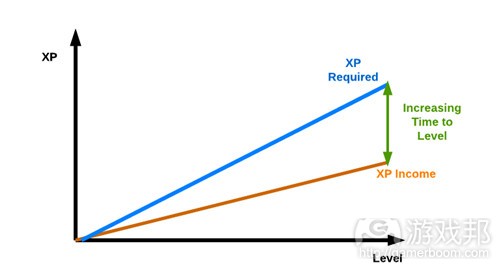

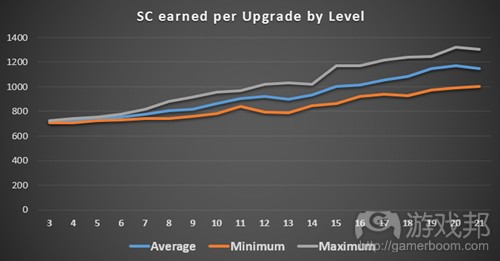
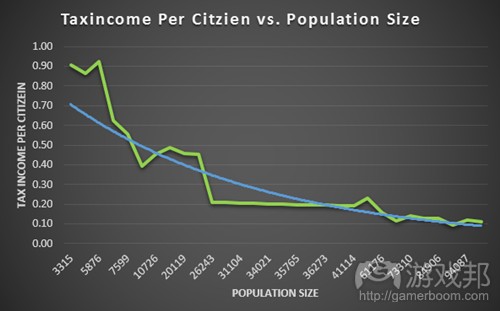
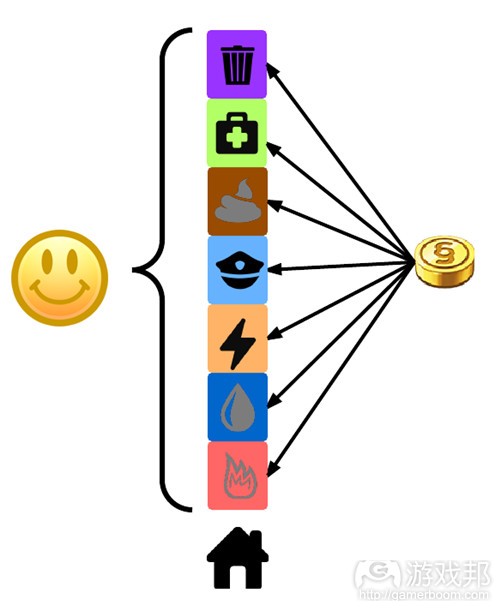
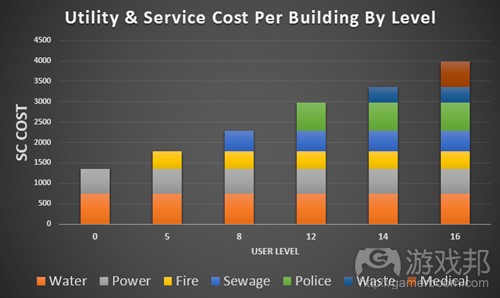

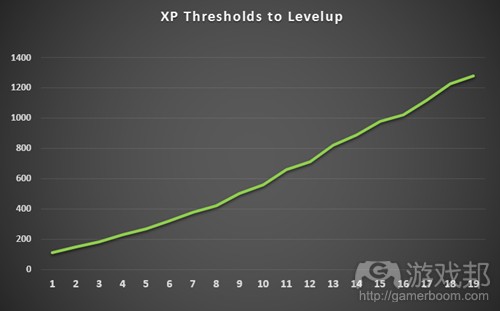
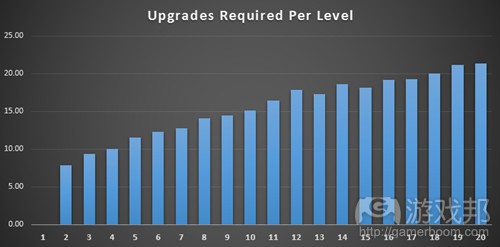
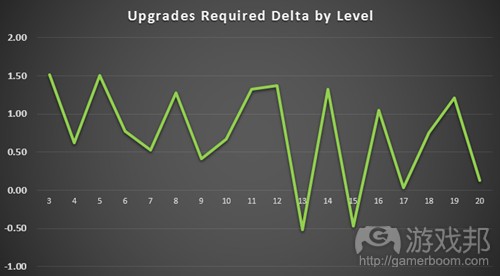

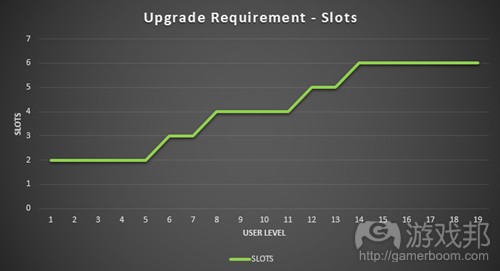
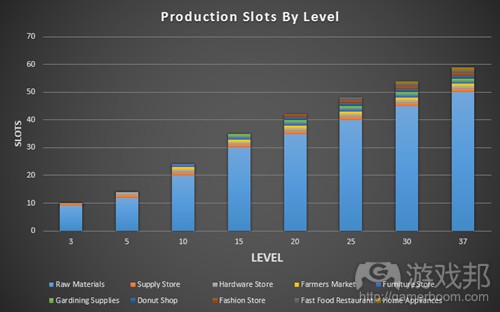

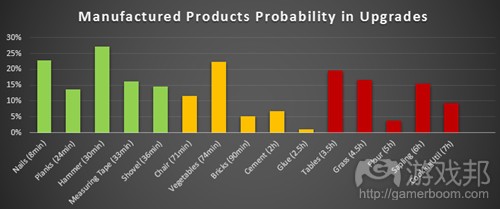














 闽公网安备35020302001549号
闽公网安备35020302001549号